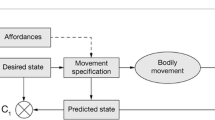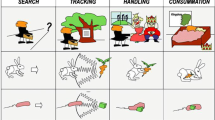Abstract
The ecological approach to perception-action is unlike the standard approach in several respects. It takes the animal-in-its-environment as the proper scale for the theory and analysis of perception-action, it eschews symbol based accounts of perception-action, it promotes self-organization as the theory-constitutive metaphor for perception-action, and it employs self-referring, non-predicative definitions in explaining perception-action. The present article details the complexity issues confronted by the ecological approach in terms suggested by Rosen and introduces non-well-founded set theory (hyperset theory) as a potentially useful tool for expressing them. The issues and the tool are brought to focus in the concept of affordance that is the basis for explanation of prospective control of action in the ecological approach.
Similar content being viewed by others
References
Aczel P (1988) Non-well-founded Sets. Stanford: CSLI.
Barwise J, Etchemendy J (1987) The Liar: An Essay on Truth and Circularity. New York: Oxford University Press
Barwise J, Moss L (1996) Vicious Circles. Stanford: CSLI.
Boden MA (1999) Is metabolism necessary? British Journal for the Philosophy of Science 50: 231–248.
Boden MA (2000) Autopoiesis and life. Cognitive Science Quarterly 1: 117–145.
Bunge M (1977) Treatise on Basic Philosophy, Vol. 3. Dordrecht: Reidel.
Chemero A (2003a) Radical empiricism through the ages. Contemporary Psychology 48: 18–20.
Chemero A (2003b) An outline of a theory of affordances. Ecological Psychology 15: 181–195.
Cummins R (1975) Functional analysis. Journal of Philosophy 72: 741–765.
Feferman S (1988) Turing in the land of 0(z). In: The Universal Turing Machine: A Half-century Survey (Herken R, ed), 113–147. Oxford: Oxford University Press.
Feferman S (1998) In Light of Logic. Oxford: Oxford University Press.
Fodor J (2000) The Mind Doesn’t Work that Way. Cambridge, MA: MIT Press.
Gibson JJ (1977) The theory of affordances. In: Perceiving, Acting, and Knowing (Shaw RE, Bransford J, eds), 67–82. Hillsdale, NJ: Erlbaum.
Gibson JJ (1979) The Ecological Approach to Visual Perception. Boston: Houghton Mifflin.
Gupta A (1982) Truth and paradox. Journal of Philosophical Logic 11: 1–60.
Gupta A, Belnap N (1993) The Revision Theory of Truth. Cambridge, MA: MIT Press.
Kant I (2000) The Critique of Judgment (Bernard JH, trans). Amherst, NY: Promethius Press. German orig. 1790.
Kercel SW (2002) Endogenous causes-bizarre effects. Evolution and Cognition 8: 130–144.
Kleene S (1950) Introduction to Metamathematics. Princeton: van Nostrand.
Kugler P, Turvey M (1987) Information, natural law, and the self-assembly of rhythmic movement. Hillsdale, NJ: Erlbaum.
Lawvere FW, Schanuel S (1997) Conceptual Mathematics. Cambridge: Cambridge University Press.
Lewontin RC (1983) Gene, organism and environment. In: Evolution From Molecules to Men (Bendall DS, ed), 273–285. Cambridge: Cambridge University Press.
McClamrock R (1995) Existential Cognition: Computational Minds in the World. Chicago: University of Chicago Press.
Michaels CF, Carello C (1981) Direct Perception. Englewood Cliffs, NJ: Prentice-Hall.
Millikan R (2000) On Clear and Confused Ideas. Cambridge: Cambridge University Press.
Moreno A, Ruiz-Mirazo K (1999) Metabolism and the problem of its universalization. BioSystems 49: 45–61.
Nicolis G, Prigogine I (1989) Exploring Complexity: An Introduction. New York: Freeman.
Oyama S (1985) The Ontogeny of Information: Developmental Systems and Evolution. Cambridge: Cambridge University Press.
Oyama S, Griffiths PE, Gray RD (2003) Cycles of Contingency. Cambridge, MA: MIT Press.
Poincare H (1906) Les mathématiques et la logique, Revue de métaphysique et de morale 14: 294–317. Reprinted in: Poincaré, Russell, Zermelo et Peano. Textes de la discussion sur les fondements des mathématiques (Heinzmann G, éd), 11–53. Paris: Blanchard.
Quine WVO (1963) Set Theory and its Logic. Cambridge, MA: Harvard University Press.
Reed ES (1996) Encountering the World. New York: Oxford University Press.
Rosen R (1988) Effective processes and natural law. In: The Universal Turing Machine (Herken R, ed), 523–537. Oxford: Oxford University Press.
Rosen R (1991) Life Itself. New York: Columbia University Press.
Rosen R (2000) Essays on Life Itself. New York: Columbia University Press.
Russell B (1902) Principles of Mathematics. Cambridge: Cambridge University Press.
Sanders JT (1997) An ontology of affordances. Ecological Psychology 9: 97–112.
Schrödinger E (1944) What is Life? Cambridge: Cambridge University Press.
Shapiro JA (2006) Genome informatics: The role of DNA in cellular computations. Biological Theory 1: 288–301.
Shaw R, Turvey MT (1981) Coalitions as models for Ecosystems: A Realist Perspective on Perceptual Organization. In: Perceptual Organization (Kubovy M, Pomerantz J, eds), 343–415. Hillsdale, NJ: Erlbaum.
Shaw R, Turvey MT (1999) Ecological foundations of cognition: II. Degrees of freedom and conserved quantities in animal-environment systems. Journal of Consciousness Studies 6: 111–124.
Soodak H, Iberall A (1987) Thermodynamics and complex systems. In: Self-organizing Systems: The Emergence of Order (Yates E, ed), 459–469. New York: Plenum Press.
Stoffregen T (2003) Affordances as properties of the animal-environment system. Ecological Psychology 15: 115–134.
Swenson R, Turvey MT (1991) Thermodynamic reasons for perception-action cycles. Ecological Psychology 3: 317–348.
Turvey MT (1992) Affordances and prospective control: An outline of the ontology. Ecological Psychology 4: 173–187.
Turvey MT (2004a) Impredicativity, dynamics, and the perception-action divide. In: Coordination Dynamics: Issues and Trends. Vol. 1: Applied Complex Systems (Jirsa VK, Kelso JAS, eds), 1–20. New York: Springer.
Turvey MT (2004b) Space (and its perception): The first and final frontier. Ecological Psychology 16: 25–29.
Turvey MT, Shaw R, Reed E, Mace W (1981) Ecological laws of perceiving and acting: In reply to Fodor and Pylyshyn (1981). Cognition 9: 237–304.
Turvey MT, Shaw RE (1995) Towards an ecological physics and a physical psychology. In: The Science of the Mind: 2001 and Beyond (Solso R, Massero D, eds), 144–169. Oxford: Oxford University Press.
Vera AH, Simon HA (1993) Situated action: A symbolic interpretation. Cognitive Science 17: 7–48.
Author information
Authors and Affiliations
Corresponding author
Rights and permissions
About this article
Cite this article
Chemero, A., Turvey, M.T. Complexity, Hypersets, and the Ecological Perspective on Perception-Action. Biol Theory 2, 23–36 (2007). https://doi.org/10.1162/biot.2007.2.1.23
Received:
Accepted:
Published:
Issue Date:
DOI: https://doi.org/10.1162/biot.2007.2.1.23




